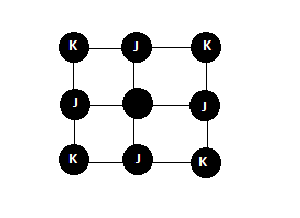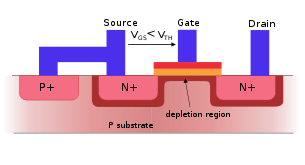Midterm 2 Solutions: Difference between revisions
No edit summary |
No edit summary |
||
| Line 85: | Line 85: | ||
b) Since Coulomb interactions are long range by <math>e^2/r</math> high densities cause the formation of solids such as crystals. | b) Since Coulomb interactions are long range by <math>e^2/r</math> high densities cause the formation of solids such as crystals. | ||
f) Where <math>T \rightarrow \infty</math> Fermi-Dirac Statistics and all quantum effects can be ignored | f) Where <math>T \rightarrow \infty</math> Fermi-Dirac Statistics and all quantum effects can be ignored. | ||
Revision as of 09:49, 9 April 2011
Problem 1
Consider a magnetic system described by an Ising model on a square lattice with . Here, the ferromagnetic interaction couples only nearest-neighbor spins. In contrast,the antiferromagnetic interaction couples only the the second neighbors, i.e. spins that are "across the square" ( diagonally placed relative to each other).
a)
Sketch the suare lattice and determine the number of first neighbors which interact ferromagnetically with the given spin, and the number of second neighbors which interact antiferromagnetically with the given spin. (5points)
Image of square lattice with ferromagnetic coupling nearest neighbor spins. Anti-ferromagnetic coupling only second nearest neighbors.
b)
Use the mean-field approximation, where . Assume that the magnitude of is appreciably larger then the magnitude of ; then the system will order ferromagnetically at low temperatures, so that for any site. Derive the self consistency condition determining the magnetization "m". (15points)
The point of the mean-field approximation is to simplify a many body problem. To consider all the interactions taking place in a material would require huge amounts of computing power and resources. The mean-field approximation accomplishes this by considering only the average of the interactions.
The first step in this problem is to right down our equation for the energy when is "appreciably larger than .
We also know:
This is due to the fact that we are considering many neighbors, so as z gets very large then we get the following:
Now if we sum over many random variables we get the following:
Now we can simplify our original expression as the following:
Pulling out the constants we get:
Since we have a problem of non interacting spins in an internal field we can consider and solve for only one spin. This then gives us the following:
Now we need to consider the probability for the spin to point either up or down. This is given as the following:
We can also define z as:
Now we can define the magnetization as the spin times the probability of the spin:
Rewriting this equation we get:
This is the same as the tanh, so we get:
Making
We get:
Problem 2
b) Since Coulomb interactions are long range by high densities cause the formation of solids such as crystals.
f) Where Fermi-Dirac Statistics and all quantum effects can be ignored.































